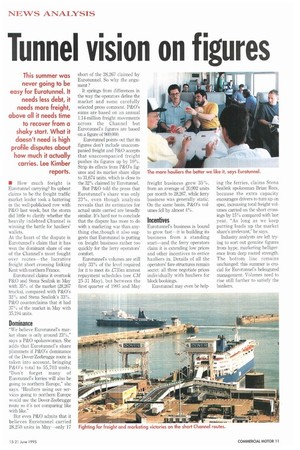Tunnel vision on figures
Page 13

If you've noticed an error in this article please click here to report it so we can fix it.
• How much freight is Eurotunnel carrying? Its upbeat claims to be the freight traffic market leader took a battering in the well-publicised row with P&O last week, but the storm did little to clarify whether the heavily indebted Chunnel is winning the battle for hauliers' wallets.
At the heart of the dispute is Eurotunnel's claim that it has won the dominant share of one of the Channel's most fought over routes—the lucrative freight short crossing linking Kent with northern France.
Eurotunnel claims it overtook P&O and Stena Sealink in May with 35% of the market (28,267 trucks), compared with P&O's 32% and Stena Sealink's 33%. P&O counterclaims that it had 37% of the market in May with 35,194 units.
Dominance
"Vie believe. Eurotunnel's market share is only around 23%," says a P&O spokeswoman. She adds that Eurotunnel's share plummets if P&O's dominance of the Dover/Zeebrugge route is taken into account, bringing P&O's total to 55,703 units. "Don't forget many of Eurotunnel's lorries will also be going to northern Europe," she says. "Hauliers using our services going to northern Europe would use the Dover-Zeebrugge route so its not comparing like with like."
But even P&O admits that it believes Eurotunnel carried 28,250 units in May—only 17 short of the 28,267 claimed by Eurotunnel. So why the argument?
It springs from differences in the way the operators define the market and some carefully selected press comment. P&O's sums are based on an annual 1.14-million freight movements across the Channel but Eurotunnel's figures are based on a figure of 969,000.
Eurotunnel points out that its figures don't include unaccompanied freight and P&O accepts that unaccompanied freight pushes its figures up by 10%. Strip its effects from P&O's figures and its market share slips to 31,674 units, which is close to the 32% claimed by Eurotunnel.
But P&O told the press that Eurotunnel's share was only 23%, even though analysis reveals that its estimates for actual units carried are broadly similar. It's hard not to conclude that the dispute has more to do with a marketing war than anything else,though it also suggests that Eurotunnel is putting on freight business rather too quickly for the ferry operators' comfort.
Eurotunnel's volumes are still only 33% of the level required for it to meet its L7:35in interest repayment schedules (see al/ 25-31 May), but between the first quarter of 1995 and May freight business grew 35%, from an average of 20,992 units per month to 28,267, while ferry business was generally static. On the same basis, P&O's volumes fell by almost 4%.
Incentives
Eurotunnel's business is bound to grow fast—it is building its business from a standing start—and the ferry operators claim it is extending low prices and other incentives to entice hauliers in. Details of all the operators' fare structures remain secret: all three negotiate prices individually with hauliers for block bookings.
Eurotunnel may even be help ing the ferries, claims Stena Sealink spokesman Brian Rees, because the extra capacity encourages drivers to turn up on spec. increasing total freight volumes carried on the short crossings by 15% compared with last year. "As long as we keep putting loads up the market share's irrelevant," he says.
Industry analysts are left trying to sort out genuine figures from hype, marketing belligerence from deep rooted strength. The bottom line remains unchanged: this summer is crucial for Eurotunnel's beleagured management. Volumes need to rise still further to satisfy the bankers.
























































































































